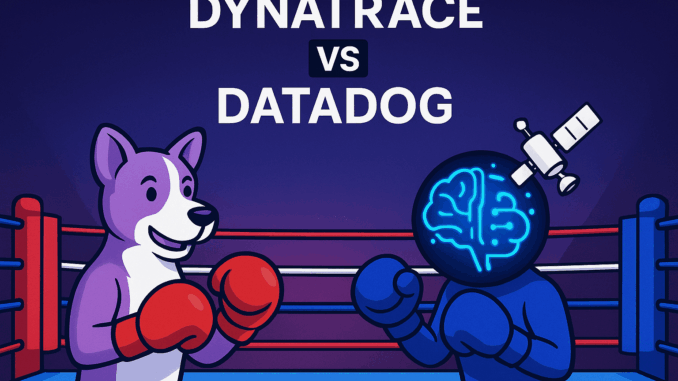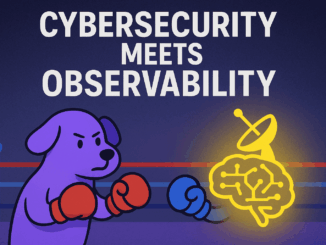
In today’s cloud-first world, observability has become more than just dashboards and logs. Enterprises want end-to-end visibility, AI-driven insights, and increasingly, built-in cybersecurity. That’s where two giants—Dynatrace (NYSE: DT) and Datadog (NASDAQ: DDOG)—dominate the conversation. Both companies sit at the heart of the observability market, but their approaches differ in scale, focus, and execution. Let’s break down the matchup: Dynatrace vs. Datadog.
1. Market Share: Who’s Watching Who?
When it comes to observability, both vendors are leaders, but the numbers tell an interesting story:
- Dynatrace commands a larger mindshare among enterprise users, with 13.6% as of late 2024, compared to Datadog’s 10.6%.
- Datadog, however, has broader revenue scale, reporting over $3.3 billion in 2025, a clear indicator of its strong customer acquisition and rapid growth in the mid-market and SMB segments.
Takeaway: Dynatrace resonates more deeply with enterprise customers, while Datadog dominates in overall adoption and revenue growth.
2. Observability: Full Stack vs. Modular Flexibility
- Dynatrace: Known for its OneAgent technology, Dynatrace auto-discovers every component across complex enterprise environments—applications, microservices, Kubernetes clusters, and hybrid clouds. Its Davis AI engine provides automated root-cause analysis and precise contextual insights.
- Datadog: Offers a modular approach, letting organizations pick and choose from dozens of monitoring tools: APM, logs, infrastructure, RUM, synthetics, and more. It’s lightweight, intuitive, and integrates quickly, making it ideal for DevOps teams scaling fast.
Takeaway: Dynatrace is the “all-in-one autopilot” for complex enterprises. Datadog is the “build-your-own toolkit” for agile teams.
3. Cybersecurity: Built-In Defense vs. Add-On Arsenal
- Dynatrace: Security isn’t an afterthought—it’s integrated. With Runtime Application Self-Protection (RASP), real-time vulnerability monitoring, and AI-driven prioritization, Dynatrace proactively blocks threats like SQL injection or Log4Shell exploits. It also offers Security Posture Management (CSPM, KSPM, VSPM).
- Datadog: Expanding fast in security, Datadog now includes Application Security Monitoring (ASM), Cloud Security Posture Management (CSPM), and SIEM-like analytics. At its 2025 DASH conference, Datadog launched AI-powered security tools to improve detection and response across cloud workloads.
Takeaway: Dynatrace leads in deep, enterprise-grade runtime protection, while Datadog excels in breadth and integration with its observability ecosystem.
4. AI: Davis vs. Bits AI
- Dynatrace’s Davis AI provides full-stack correlation, automated root cause analysis, and proactive anomaly detection. Think of it as an enterprise-grade autopilot.
- Datadog’s Bits AI focuses on natural language queries and smart assistance, making it easier for teams to interact with observability data without steep learning curves.
Takeaway: Dynatrace’s AI goes deep into automation and enterprise remediation, while Datadog’s AI aims to make observability accessible and actionable for all teams.
5. Cost and Complexity
- Dynatrace: Premium pricing, steeper learning curve, but long-term ROI comes from automation and reduced downtime in complex environments.
- Datadog: Easier onboarding and flexible pricing, but costs can spike quickly with high data ingestion, making budgeting unpredictable at scale.
6. Who Wins? It Depends on You
- Choose Dynatrace if: You’re a large enterprise with hybrid/multi-cloud complexity, and security + automation are mission-critical.
- Choose Datadog if: You’re a fast-scaling organization that values flexibility, ease of use, and a wide ecosystem of integrations—even if security depth isn’t as strong.
Final Word
In the battle of Dynatrace vs. Datadog, there’s no one-size-fits-all winner. Dynatrace shines in enterprise observability and integrated security, while Datadog wins in flexibility, adoption, and developer-friendliness.
As the observability market grows into a $6+ billion industry by 2030, both stocks—DT and DDOG—are well-positioned for long-term upside. The real question isn’t which one is better overall, but which one better fits your business needs and investment strategy.



Be the first to comment